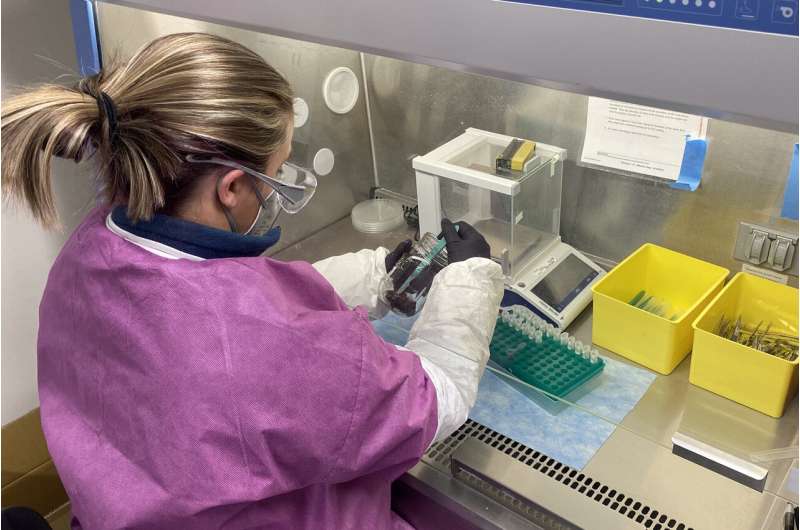This article has been reviewed according to Science X's editorial process and policies. Editors have highlighted the following attributes while ensuring the content's credibility:
fact-checked
trusted source
proofread
Understanding chronic wasting disease in deer

Chronic wasting disease (CWD) is a transmissible, neurodegenerative disorder in deer that causes inability to eat, stumbling, drooling, and lack of fear of humans, and in all cases is ultimately fatal. "You can have deer that are infected live for two or more years, and it can take a very long time before they show clinical signs of it," says Michelle Gibison, diagnostic laboratory testing manager at the University of Pennsylvania School of Veterinary Medicine's Wildlife Futures Program. That means they can infect other deer in that time.
CWD is a prion disease, meaning it results from a normal cellular protein that has misfolded and then spreads by misfolding additional copies of the protein. Gibison says while there is no evidence CWD can spread to humans, there is concern this could change, as other prion diseases—such as Mad Cow Disease—can spread through the consumption of infected meat. She says CWD cases are increasing, not only in Pennsylvania and the United States but also across the world.
Through collecting and analyzing fecal samples from animals with and without CWD, a new collaborative study from Penn Vet and other researchers sheds light on how CWD impacts the gut microbiome and provides a potential tool for disease surveillance.
The researchers found that several types of gut bacteria could differentiate between CWD-positive and -negative animals. Their paper "Prospective fecal microbiomic biomarkers for chronic wasting disease" was published in Microbiology Spectrum.
They analyzed 100 fecal samples from white-tailed deer from different regions of the U.S., of which half have chronic wasting disease and half do not. CWD has been challenging to surveil because disease confirmation has largely required postmortem diagnostics, says Anna Kashina, professor of biochemistry at Penn Vet.
There has been no noninvasive, live-animal test for CWD, which is believed to be transmitted via the accidental ingestion or contact with prions deposited into the environment through feces, saliva, urine, and animal remains.
"This work is the start of a very promising trend to use fecal samples to both identify the disease and also learn more about the biology of the disease," Kashina says.
In CWD-positive deer, the study found similar changes in the deer diagnosed with earlier-stage and later-stage CWD, indicating that changes related to CWD precede symptoms. Julie Ellis, co-director of Penn Vet's Wildlife Futures Program, says this methodology may prove useful for earlier detection of CWD, especially in areas where CWD spread may not have been previously reported.
The project, she says, highlights Penn's ability to bring together collaborators with diverse expertise and skill sets. Ellis is an ecologist working in wildlife health, Gibison has a background in molecular biology and oversees CWD diagnostics, and Kashina is a basic scientist who works with cell and animal models and is focused on neurodegeneration.
Dawei W. Dong of Penn Vet is an expert in machine learning and artificial intelligence and is a co-senior author on this study. They collaborated with other researchers from Penn Vet along with Merck and the United States Department of Agriculture.
Gibison says the Wildlife Futures Program is also unique in having seven wildlife health technicians spread across the state to help with specimen collection and disease surveillance.
A next step in Penn's CWD research is looking at captive and wild deer in Pennsylvania rather than captive deer across the country, which Kashina says is important because it eliminates the variability of geographic regions, which normally has a strong impact on the microbiome. The reasons for the connection between CWD and changes in the fecal microbiome remain uncertain.
One of Kashina's longer-term hopes is development of fecal testing that hunters can utilize in the field. Catching CWD when it moves to a new area is important, Gibison says. Once the disease becomes endemic, it's hard to eradicate.
More information: Adam Didier et al, Prospective fecal microbiomic biomarkers for chronic wasting disease, Microbiology Spectrum (2024). DOI: 10.1128/spectrum.03750-22
Provided by University of Pennsylvania




















